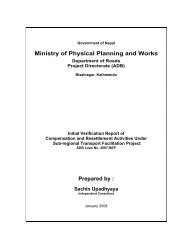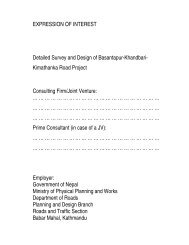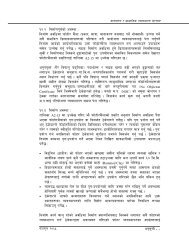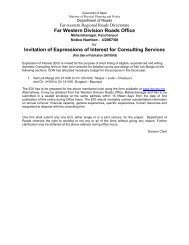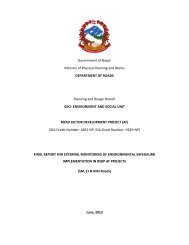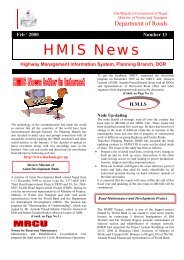Environmental & Social Management Framework - About ...
Environmental & Social Management Framework - About ...
Environmental & Social Management Framework - About ...
Create successful ePaper yourself
Turn your PDF publications into a flip-book with our unique Google optimized e-Paper software.
<strong>Environmental</strong> and <strong>Social</strong> <strong>Management</strong> <strong>Framework</strong>basic services to the disadvantaged and indigenous people, Dalits 4 , women,disabled and other vulnerable groups including the Adhibasi / Janajati indigenouspeople. One of the main thrusts of the Tenth Plan is the implementation oftargeted programs for the uplift, employment and basic security of Dalits,indigenous people and disabled class. The policy provision also outlines that thegovernment should pilot strong and separate package of program of basicsecurity for vulnerable sections of society.The National Dalit Commission (commission for oppressed) was constituted inthe Ninth Plan for the protection of their rights and inclusion in the mainstream ofdevelopment programs. The acts and regulations of the commission areformulated as well as work related to setting up institutional structure has beenundertaken.GoN’s Tenth Plan is the guiding policy document for any development project tointegrate programs aimed at poverty reduction, especially among the poor. TheTargeted Program is one of the four strategic poverty reduction pillars upon whichthe Tenth Plan is formulated and being implemented. Targeted programs in thecontext of poverty reduction are meant to enhance the capability of thosecommunities and areas which are lagging behind in the main stream ofdevelopment. The Plan states that targeted and empowerment programs shall bepromoted to enhance the welfare of vulnerable, disadvantaged and exploitedgroups, the Dalits and indigenous scheduled caste groups.The objective of the targeted program is to raise productive capabilities of peoplebelong to marginalized, deprived, disadvantaged, remote and isolated areas. Theexpected results of Targeted Programs are (i) improving livelihood of Dalits,indigenous people, and any other deprived local groups, and (ii) empowerment ofthese groups for self-help development.The Tenth Plan also defines that the areas where more than 50 percent ofpopulation is poor and the families have no extra income other than their ownhousehold production and which is sufficient for less than 9 months aredesignated as the ‘poor areas’. Likewise families whose income is sufficient forless than three months is categorized as ‘ultra poor’ who need to be supportedfor their livelihoods. The Tenth Plan makes specific reference and povertyalleviation activities, such as:• Construction of Local Level Infrastructure and Local Development Program:One of the targeted programs in the Tenth Plan is the construction of locallevel infrastructure development. Infrastructure like drinking water, minorirrigation, foot/ mule trails, school and health posts are amongst suchprograms.• Programs of Increasing Income Generating Opportunities: There is alsoincreased emphasis in implementing different types of income generationsupportive programs targeting the poor and vulnerable people. It is alsorecognized that some dalit groups like Kami (blacksmith), Damai (tailor),Sarki (cobbler) etc. have been losing markets of their traditionaloccupations. The imported cheaper goods in the market have greatlyreplaced the demand of local made goods both in urban and rural areas.4 Dalits are traditionally the most poor and vulnerable communities elsewhere in the countryleaving a very few exceptions who are educated and economically better off. The customarypractice while defining the poor is that all dalits are put in to this category implying the fact thatpoverty is prevalent widely among the dalits of Nepal.According to census survey (CBS, 2001), NPC has estimated a total of 3.1 million populationas Dalits with more than 20 different ethnic groups. This figure accounts for 13.3 percent of thetotal population of Nepal. The hill dalits include mainly Damai, Kami Sarki Gaine, Pode Kusle,Kasai etc while the Terai Dalits constitute Teli, Dusadh, Chamar Musahar and others.Chapter 3-14 April 2007



![j:6 ]zg cfof ]hgf](https://img.yumpu.com/51286794/1/190x245/j6-zg-cfof-hgf.jpg?quality=85)

![x'nfsL /fhdfu { cfof ]hgf](https://img.yumpu.com/50581959/1/190x245/xnfsl-fhdfu-cfof-hgf.jpg?quality=85)
